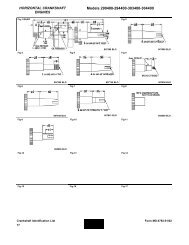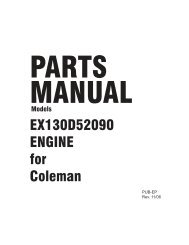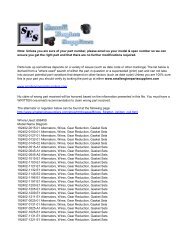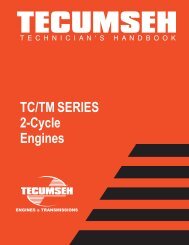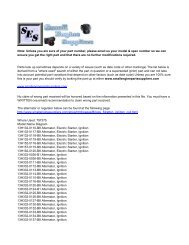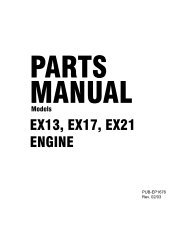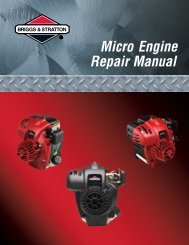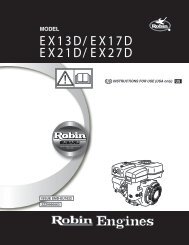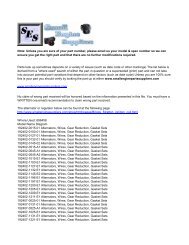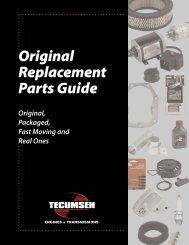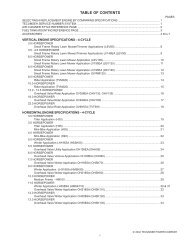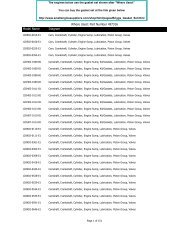3to 11hp 4-cycle l-head engines - Small Engine Suppliers
3to 11hp 4-cycle l-head engines - Small Engine Suppliers
3to 11hp 4-cycle l-head engines - Small Engine Suppliers
Create successful ePaper yourself
Turn your PDF publications into a flip-book with our unique Google optimized e-Paper software.
IMPULSE FUEL PUMPS<br />
Impulse fuel pumps may either be mounted externally<br />
onto the carburetor fuel inlet or remotely mounted. These<br />
pumps are connected in the fuel line between the fuel<br />
supply and the carburetor or directly to the fuel inlet.<br />
Impulse fuel pumps are operated by crankcase impulses<br />
created by the up and down movement of the piston. A<br />
hose called a pulse line connects the fuel pump diaphragm<br />
chamber to the crankcase and transmits these impulses<br />
to the pump diaphragm. The impulses actuate the<br />
diaphragm and flap valves to lift the fuel from the fuel tank<br />
to the carburetor (diag. 6).<br />
6<br />
FLOAT STYLE CARBURETORS<br />
A float is used to maintain the operating volume of fuel in<br />
the carburetor bowl. As the fuel is used by the engine, the<br />
fuel volume in the carburetor bowl drops and the float moves<br />
downward. This allows the inlet needle valve to move off<br />
the sealing seat. Fuel flows by gravity or a pulse pump<br />
into the fuel bowl. As the fuel volume in the bowl again<br />
rises, it raises the float. This upward float motion moves<br />
the inlet needle valve to the closed position. When the<br />
needle contacts the seat, the fuel flow is stopped. The<br />
tapered end of the inlet needle varies the fuel flow rate so<br />
that the fuel volume in the carburetor bowl will remain<br />
constant (diag. 7). The float height is set according to the<br />
service procedure.<br />
IDLE AND<br />
PROGRESSION<br />
HOLES<br />
THROTTLE<br />
SHUTTER<br />
IDLE<br />
ADJUSTMENT<br />
IDLE AIR<br />
BLEED<br />
MAIN AIR<br />
BLEED<br />
CHOKE<br />
SHUTTER<br />
INLET NEEDLE<br />
AND SEAT<br />
FLOAT<br />
DIAPHRAGM (PRESSURE DIFFERENTIAL)<br />
CARBURETORS<br />
MAIN NOZZLE<br />
EMULSION<br />
TUBE<br />
MAIN<br />
ADJUSTMENT<br />
7<br />
This type of carburetor uses a rubber-like diaphragm which<br />
is exposed to intake manifold pressure on one side and to<br />
atmospheric pressure on the other. Tecumseh diaphragm<br />
carburetors use the diaphragm as a metering device. As<br />
the intake manifold pressure decreases due to downward<br />
piston travel, the atmospheric pressure on the vented side<br />
of the diaphragm moves the diaphragm against the inlet<br />
needle. The diaphragm movement overcomes the spring<br />
tension on the inlet needle and moves the inlet needle off<br />
the seat. This permits the fuel to flow through the inlet<br />
valve to maintain the correct fuel volume in the fuel<br />
chamber. The inlet needle return spring closes the inlet<br />
valve when the pressure on the diaphragm equalizes or a<br />
pressure higher than atmospheric exists on the intake side<br />
(upward piston travel). The diaphragm meters a correct<br />
fuel volume in the fuel chamber to be delivered to the mixing<br />
passages and discharge ports (diag. 8).<br />
THROTTLE<br />
SHUTTER<br />
IDLE<br />
ADJUSTMENT<br />
CHECK BALL<br />
CHOKE<br />
SHUTTER<br />
NEEDLE AND<br />
SEAT ASSEMBLY<br />
A main or idle adjustment needle may be replaced by an<br />
internally fixed jet on some models.<br />
MAIN<br />
ADJUSTMENT<br />
DIAPHRAGM<br />
The main nozzle contains a ball check valve. The main<br />
purpose of this ball check is to eliminate air being drawn<br />
down the main nozzle during idle speeds and leaning the<br />
idle mixture.<br />
8<br />
An advantage of the diaphragm carburetor over the float<br />
system is that the diaphragm carburetor increases the angle<br />
that the engine may be operated at.<br />
9



